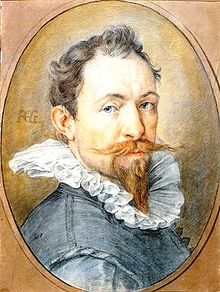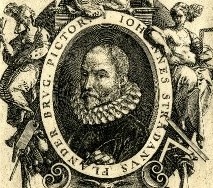Details
The other 3 probably engraved by Philips Galle (his name on plate 1 as 'sculpsit')
The group of 21 (8+8+4+T) was published with the series title:
Mediceae Familiae Rerum Feliciter Gestarum Victoriae et Triumphi / Mediceae
Familiae Rerum Feliciter Gestarum Victoriae et Triumphi
With wide margins on a sheet of laid paper measuring 29 by 37 cm.
Watermarked twice (mark and contra mark)
Early state published by Philips Galle.
Inventor: Johannes Stradanus ( New Hollstein 354 )
Publisher: Philips Galle ( New Hollstein 488-503)
Reference: Baroni Vannucci 691.11
Additional Information
| SKU | xxr321 |
|---|---|
| Picture Size | 22 x 29,50 cm |
| Specification | |
| technic | Engraving |
| Artist | Hendrick Goltzius |
| period | 16th Century |
| School | Flemish |
| subject | Battle Scenes |
| rating | **** |
Hendrick Goltzius (1558-1647)
 Dutch printmaker, draftsman, and painter. He was the leading Dutch engraver of the early Baroque period, or Northern Mannerism, noted for his sophisticated technique and the "exuberance" of his compositions. Goltzius was born near Venlo in Bracht or Millebrecht in North Rhine-Westphalia. His family moved to Duisburg when he was 3 years old. After studying painting on glass for some years under his father, he learned engraving from the Dutch polymath Dirck Volckertszoon Coornhert, who then lived in Cleves. In 1577 he moved with Coornhert to Haarlem. In the same town, he was also employed by Philip Galle to engrave a set of prints of the history of Lucretia. Goltzius had a malformed right hand from a fire when he was a baby which turned out to be especially well-suited to holding the burin; "by being forced to draw with the large muscles of his arm and shoulder, he mastered a commanding swing of line.
Dutch printmaker, draftsman, and painter. He was the leading Dutch engraver of the early Baroque period, or Northern Mannerism, noted for his sophisticated technique and the "exuberance" of his compositions. Goltzius was born near Venlo in Bracht or Millebrecht in North Rhine-Westphalia. His family moved to Duisburg when he was 3 years old. After studying painting on glass for some years under his father, he learned engraving from the Dutch polymath Dirck Volckertszoon Coornhert, who then lived in Cleves. In 1577 he moved with Coornhert to Haarlem. In the same town, he was also employed by Philip Galle to engrave a set of prints of the history of Lucretia. Goltzius had a malformed right hand from a fire when he was a baby which turned out to be especially well-suited to holding the burin; "by being forced to draw with the large muscles of his arm and shoulder, he mastered a commanding swing of line.Goltzius brought to an unprecedented level the use of the "swelling line", where the burin is manipulated to make lines thicker or thinner to create a tonal effect from a distance. He also was a pioneer of "dot and lozenge" technique, where dots are placed in the middle of lozenge shaped spaces created by cross-hatching to further refine tonal shading. Hollstein credits 388 prints to him, with a further 574 by other printmakers after his designs. In his command of the burin, Goltzius is said to rival Dürer. He made engravings of Bartholomeus Spranger's paintings. Goltzius began painting at the age of forty-two; some of his paintings can be found in Vienna. He also executed a few chiaroscuro woodcuts. He was the stepfather of engraver Jacob Matham. He died, aged 58, in Haarlem.
Inventor
Stradanus, Johannes (1523-1605)
 Latin name for Jan van der Straet. Born 1523 in Bruge, Belgium, Stradanus, actually Jan van der Straet, received this first raining as an artist from his father. He moved to Antwerp in 1537 and began to show as a young man his talent for becoming one of the great artists in his time.
Latin name for Jan van der Straet. Born 1523 in Bruge, Belgium, Stradanus, actually Jan van der Straet, received this first raining as an artist from his father. He moved to Antwerp in 1537 and began to show as a young man his talent for becoming one of the great artists in his time.
His path to Florence, then one of the hot spots of artist life, lead Stradanus via Lyon were he briefly stayed. and a six months stint in Venice. Right away he was hired by Cosimo I de Medici to design tapistry for the court. From 1550 to approximately 1553 Stradanus where he executed works for the Vatican and worked with Francesco Salviati whose style influenced him greatly. Back in Florence Stradanus worked with Giorgio Vasari. He designed frescoes and Tapistry for the Palazzo Vecchio, work that he continued into the 1570s. In 1567 he began designing tapistry for Cosimo's villa at Poggio a Caiano near Florence. The subject matter was "Hunting". Stradanus continued this work on copper plates. The prints were successfully published.
Stradanus lived partially in Antwerp and in Naples during the late 1570s, but eventually returned to Florence where he died in 1605.
All the items are guaranteed to be originals and as described.
A letter of authenticity is added by simple request.
Items may be returned within 15 days after arrival.
I ship worldwide and provide Insurance and other delivery options.
All items can be purchased instantly at the listed prices,
on reservation of errors in price or availibility..






 Facebook
Facebook Twitter
Twitter Subscribe us
Subscribe us Flickr
Flickr




